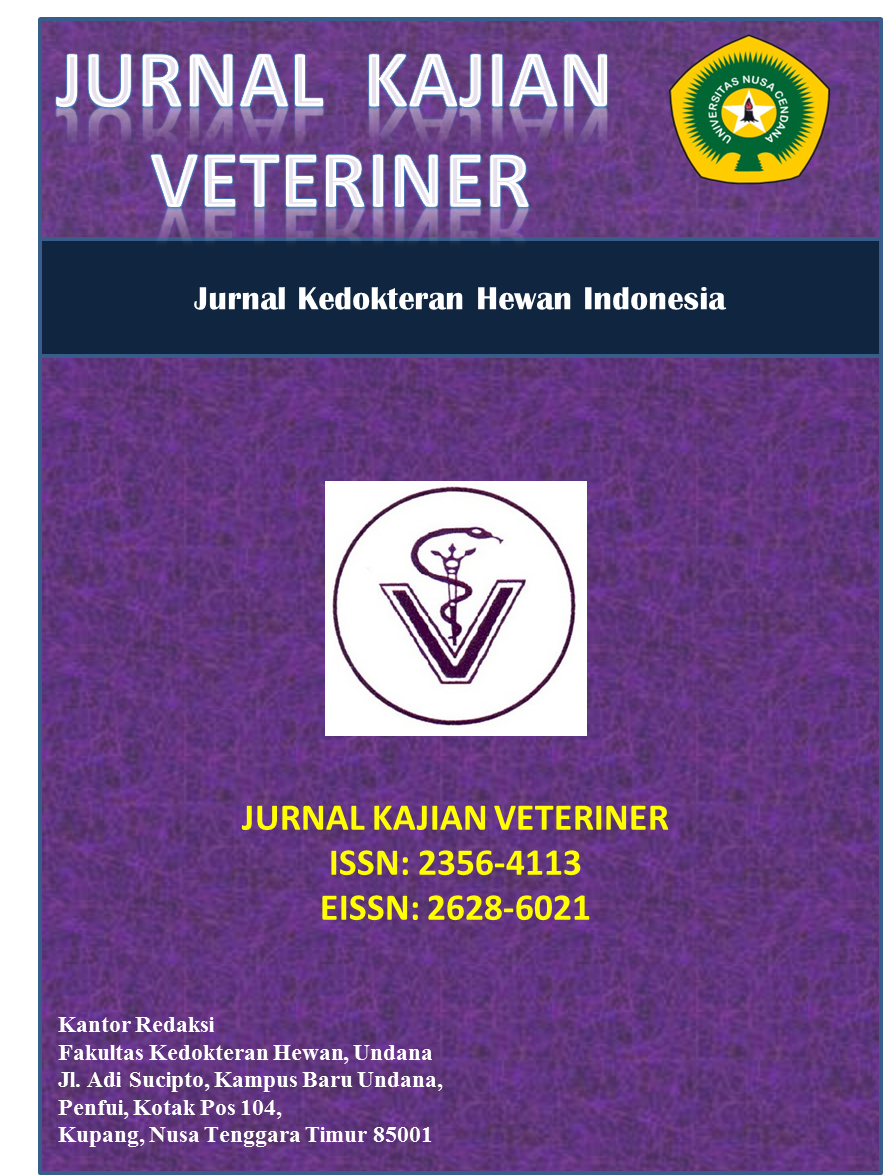STATUS FISIOLOGIS SAPI SUMBA ONGOLE (Bos indicus) DI KAWASAN PEMBIBITAN SAPI PULAU SUMBA
Physiological Status of Sumba Ongole Cattle (Bos indicus) in Sumba Breeding Farm
Abstract
Physiological status is an indicator to determine the degree of health and productivity of livestock. This study aims to identify the physiological status of Sumba Ongole (SO) beef cattle on the island of Sumba by measuring body temperature, respiration frequency, pulse, and body conditioning score (BCS). Overall, there were 70 cows used in the study. Based on gender, there were 21 bulls and 49 cows and they were classified based on age, there were 3 categories, 1-1.5 years, 2-2.5 years, and 3 years. The parameters measured were body temperature, respiratory rate, pulse frequency, and BCS. The results of the study which were processed using analysis of variances (ANOVA) showed that there was no effect of sex or age on body temperature, respiration frequency, pulse frequency (P> 0.05), but there was a significant difference in the age category with the body score of SO cattle (P<0.05). It could be concluded that the physiological status of SO beef cattle which includes body temperature, respiration frequency, and pulse frequency does not show a significant effect on both sex and age, but there is a significant difference in the body score of cattle based on age categories. This research data could probably be used later as a reference for maintaining the health management of SO beef cattle to achieve optimal productivity and profitability.
Downloads
References
Blackshaw, J. K., & Blackshaw, A. W. 1994. Heat stress in cattle and the effect of shade on production and behaviour: a review. Aus-tralian Journal of Experi-mental Agriculture, 34(2), 285-295.
Finch, V.A. 1986. Body Temperature in Beef Cattle: Its Control and Relevance to Produc-tion in the Tropics. Journal of Animal Science, 62:531–542. Doi: 10.2527/jas1986.622531x.
Gaina, C. D., Sanam, M. U., Nalley, W. M., Benu, I., & Sapu-tra, A. 2020. Blood AST and ALT profile of Sumba Ongole cattle. ARSHI Vet-erinary Letters, 4(1), 17-18.
Gaina, C. D., Sanam, M. U. E., Nal-ley, W. M. M., Benu, I., & Saputra, A. 2019. Hemato-logical profile of sumba ongole cattle extensively reared in semiarid land, Sumba, NTT based on age and sex. In IOP Confer-ence Series: Earth and Environmental Science (Vol. 387, No. 1, p. 012022). IOP Publishing.
Gallo, L., Carnier, P., Cassandro, M., Mantovani, R., Bailoni, L., Contiero, B., & Bittante, G. 1996. Change in body condition score of Holstein cows as affected by parity and mature equivalent milk yield. Journal of Dairy Science, 79(6), 1009-1015.
Gaughan, J.B., and T.L. Mader. 2014. Body temperature and respiratory dynamics in un-shaded beef cattle. International Journal of Biometeorology, 58:1443–1450. Doi: 10.1007/s00484-013-0746-8.
Gaughan, J.B., S. Bonner, I. Loxton, T.L. Mader, A. Lisle, and R. Lawrence. 2010. Effect of shade on body tempera-ture and performance of feedlot steers. Journal of Animal Science, 88:4056–4067. Doi: 10.2527/jas.2010-2987.
Hahn, G.L. 1999. Dynamic responses of cattle to thermal heat loads. Journal of Animal Science, 77:10–20. Doi: 10.2527/1997.77suppl_210x.
Hammami, H., Bormann, J., M’hamdi, N., Montaldo, H. H., & Gengler, N. 2013. Evaluation of heat stress effects on production traits and somatic cell score of Holsteins in a temperate environment. Journal of dairy science, 96(3), 1844-1855.
Hansen, P.J. 2004. Physiological and cellular adaptations of ze-bu cattle to thermal stress. Animal Reproduction Sci-ence, 82–83:349–360. Doi: https://doi.org/10.1016/j.anireprosci.2004.04.011.
Howard, J. T., Kachman, S. D., Snel-ling, W. M., Pollak, E. J., Ciobanu, D. C., Kuehn, L. A., & Spangler, M. L. 2014. Beef cattle body temperature during climat-ic stress: a genome-wide association study. Interna-tional journal of biomete-orology, 58(7), 1665-1672.
Igono, M.O., G. Bjotvedt, and H.T. Sanford-Crane. 1992. En-vironmental profile and critical temperature effects on milk production of Hol-stein cows in desert cli-mate. International Journal
of Biometeorology, 36:77–87. Doi: 10.1007/BF01208917.
Jacob, R. H., Surridge, V. S. M., Beatty, D. T., Gardner, G. E., & Warner, R. D. 2014. Grain feeding increases core body temperature of beef cattle. Animal Pro-duction Science, 54(4), 444-449.
Koatdoke, U., Katawatin, S., Sri-maraks, S., Duangjinda, M., & Phasuk, Y. 2006. Comparative study of physiological responses re-lated with thermotolerance between Bos indicus and Bos taurus. Kaen Kaset.
Mazzullo, G., Rifici, C., Caccamo, G., Rizzo, M., & Piccione, G. 2014. Effect of differ-ent environmental condi-tions on some haematolog-ical parameters in cow. Annals of Animal Science, 14(4), 947-954.
Renquist, B. J., Oltjen, J. W., Sainz, R. D., & Calvert, C. C. 2006. Effects of age on body condition and pro-duction parameters of mul-tiparous beef cows. Jour-nal of Animal Science, 84(7), 1890-1895.
Schütz, K.E., A.R. Rogers, Y.A. Poulouin, N.R. Cox, and C.B. Tucker. 2010. The amount of shade influ-ences the behavior and physiology of dairy cattle. Journal of Dairy Science, 93:125–133. Doi: https://doi.org/10.3168/jds.2009-2416.
Silanikove, N. 2000. Effects of heat stress on the welfare of ex-tensively managed domes-tic ruminants. Livestock production science, 67(1-2), 1-18.
Sprinkle, J. E., Holloway, J. W., Warrington, B. G., Ellist, W. C., Stuth, J. W., Forbes, T. D. A., & Greene, L. W. 2000. Di-gesta kinetics, energy in-take, grazing behavior, and body temperature of graz-ing beef cattle differing in adaptation to heat. Journal of Animal Science, 78(6), 1608-1624.
Taylor, C.R., D. Robertshaw, and R. Hofmann. 1969. Thermal panting: a comparison of wildebeest and zebu cattle. American Journal of Phys-iology, Content 217:907–910. Doi: 10.1152/ajplegacy.1969.217.3.907.
West, J. W., Mullinix, B. G., & Ber-nard, J. K. 2003. Effects of hot, humid weather on milk temperature, dry mat-ter intake, and milk yield of lactating dairy cows. Journal of Dairy Science, 86(1), 232-242.
Copyright (c) 2021 JURNAL KAJIAN VETERINER

This work is licensed under a Creative Commons Attribution-NonCommercial-NoDerivatives 4.0 International License.

 Cynthia Dewi Gaina(1*)
Cynthia Dewi Gaina(1*)








.png)


